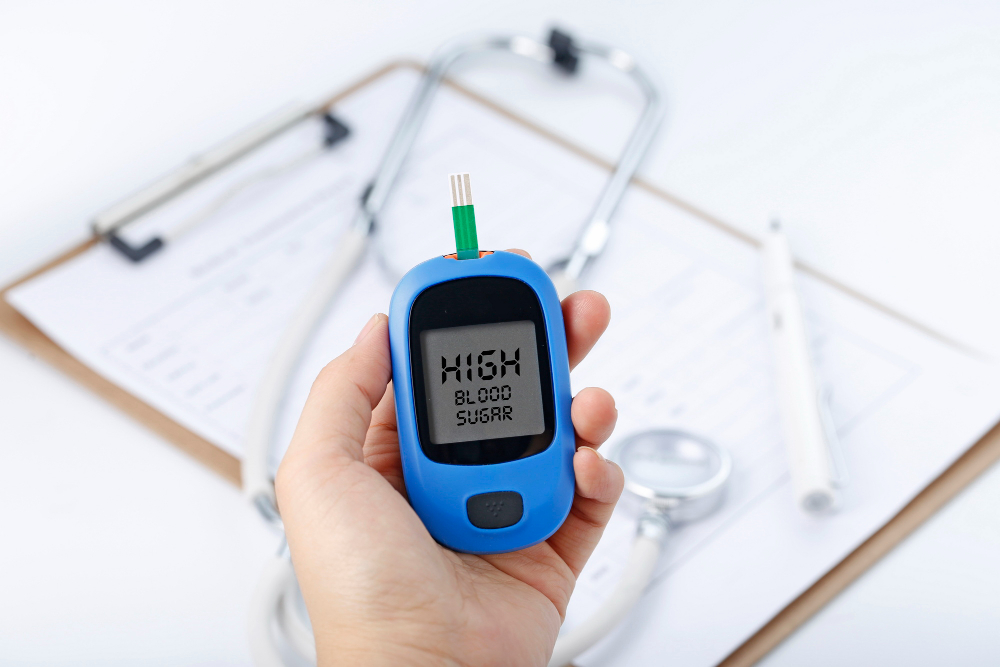No products in the cart.

Understanding Insulin Resistance
With India being referred to as the ‘Diabetes Capital of the World,’ there is an increasing need to understand how insulin resistance plays a major role in the onset and progression of Diabetes Mellitus.
What is insulin resistance?
In order to understand what insulin resistance is, we need to first comprehend the role of insulin in our body. Insulin is basically a hormone which has a role to play when glucose levels in the blood rises. The body cells need to use glucose as energy in order to bring down their levels in blood. Once the food we eat is broken down to simpler molecules like glucose, they enter the bloodstream. This signals the pancreas to produce insulin which in turn helps the glucose to enter the muscles, fat and cells to be used as energy, thus bringing down the levels in the blood.
In case of insulin resistance, the cells do not respond well to insulin. Since the cells do not open up, it results in excessive accumulation of glucose in the blood causing hyperglycemia. Prolonged hyperglycemia increases the risk for onset of prediabetes, Type 2 Diabetes, Cardiovascular diseases, Obesity, non-alcoholic fatty liver disease, etc.
What are the risk factors ?
- Overweight or obese individuals
- Family history of Type 2 Diabetes
- History of gestational diabetes
- History of heart disease or stroke
- Age of 45 years and older
- Lack of physical activity
- Polycystic ovarian syndrome (PCOS)
- Hormonal disorders
- Certain medications
- Sleep problems, e.g., sleep apnea
How is it diagnosed?
- Medical history – Conditions like gestational diabetes, PCOS, etc. could be checked for as medical history plays a major role in the onset of insulin resistance.
- Family history – Genetic history of pre-existing health conditions like Type 2 Diabetes, Cardiovascular and other metabolic syndromes can be checked.
- Physical examination – Measuring the weight, body fat percentage, waist-hip ratio, blood pressure levels, etc.
- Blood tests – Fasting plasma glucose (FPG), oral glucose tolerance test (GTT), HbA1c test, complete lipid profile, etc. can help in the clinical diagnosis.
All these above parameters combined can help diagnose insulin resistance.
How does insulin resistance progress to Type 2 Diabetes?
When the body cells are resistant to insulin, the pancreas work harder to produce extra insulin and balance the blood sugar levels. However, with time, it puts pressure on the pancreas to continue to produce more insulin if the blood sugar levels are consistently high. If lifestyle changes like modifications in diet and exercise are not made, the body continues to stay in hyperglycaemic state for a prolonged duration and the pancreas will not be able to keep up with the increase in insulin demand. This eventually leads to a condition called prediabetes where the doctor diagnoses it based on an HbA1c value of 5.7 to 6.4 %. Other clinical parameters considered are the FPG and GTT test for diagnosis. If prediabetes is not well managed, it progresses to Type 2 diabetes when the HbA1c levels rise above 6.5%.
What are ways to treat or prevent it?
- Eat healthy – A lot can be done by managing what we eat and how much glucose gets produced by the body after the food is broken down. If we can limit the carbohydrate intake and choose foods with low Glycaemic index (GI), high fiber and high protein, there are less chances of post meal hyperglycemia and better insulin sensitivity.
- Exercise – The best way is to stay active, allow the cells to utilize maximum glucose levels from the blood, prevent fat accumulation and weight gain, thus reducing the risk factors associated with chronic health conditions due to insulin resistance.
- Medication – If you are already on medication for blood glucose control, it’s important to not miss them. Medicines help in improving insulin sensitivity, reduce insulin resistance, improve insulin production and increase glucose uptake by the cells.
Along with these strategies, managing stress will also play a major role in keeping the glucose levels in check.
Closing thoughts –
Insulin resistance usually does not occur with any symptoms at the initial stage till one is diagnosed with prediabetes or Type 2 Diabetes. It is always better to get a regular / annual health check up done which can indicate the current FPG or HbA1c levels. Alternately, staying physically active helps increase the insulin sensitivity and cells are more receptive to utilise the glucose levels in the blood. A lifestyle change begins with a single step. Take yours today!

Dietitian
Nutrition Tattva




vorbelutrioperbir
I love your writing style genuinely loving this site.